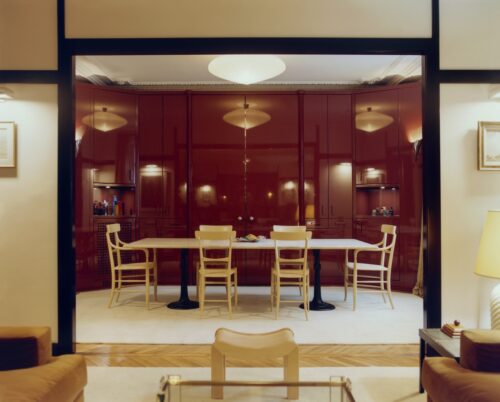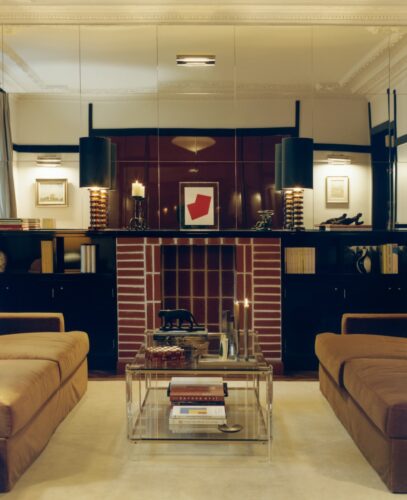Text Dzenana Mujadzic
Charlotte Albert und Alexis Lamesta von Necchi Architecture möchten Räume schaffen, die sich nicht nur durch eine einzigartige Atmosphäre auszeichnen, sondern sich auch bewusst von vertrauten Sehgewohnheiten lösen und einer bestimmten zeitlichen Einordnung entziehen. Mit ihrer Arbeit verfolgen sie das Ziel, die klassischen Kriterien der Raumgestaltung außen vor zu lassen, was die Unverkennbarkeit ihrer Projekte weiter geschärft hat.
Chapter Apart from important aspects such as sustainability and functionality, how important is the visual experience of a space to you?
Necchi Architecture We don’t create spaces based on visual impact, and we get anxious when clients who meet us for the first time describe their vision with words like »wow-effect«. However, the visual experience we create should always be associated with a sense of comfort. In order for people to experience a rather unusual sense of comfort, we believe we need to make the eye feel uncomfortable. Ultimately, by creating »visual accidents«, we are trying to challenge new ways of seeing, creating small scenarios that break with the usual criteria, but still making you feel good on an emotional level.

Chapter Although your work tends to give the impression of being from another era, there’s a certain attitude that makes it unmistakably modern. What are the key principles of your work and its aesthetic?
Necchi Architecture We’re not sure if we have any key principles, but we strongly believe that it’s important not to be afraid of judgement, of being out of step, of making mistakes and learning from them. Creating spaces also means telling a story, and if that story can be told without even being classified by date, it’s because we’ve managed to create an atmosphere, an attitude, a moment, rather than a smooth, reassuringly fashionable place. Even though we’re not trying to be backward-looking, modernity has always been created from a variety of old elements as well as from cultural heritage that goes back many decades. Using furniture that already has a history and that doesn’t seem to fit the space at first glance helps to prevent the space from becoming stale. We’re also always hoping that, over time, our clients will complement our work by adding extra layers to it, that come from their own personalities and attitudes. For us, a successful project is defined by both the client and ourselves being happy in unison.

Chapter How do you define the concept of personal taste and how does it influence the balance between individuality and timeless design in your projects?
Necchi Architecture »Everyone has their own bad taste.« In the spirit of this statement, we see taste as an attitude, not as a guide to good manners and a lesson to be learned—anything that comes naturally serves this purpose.

Chapter To what extent does your work reflect this personal taste, and is there a moment during the design process when the brief becomes more of an artistic playground?
Necchi Architecture We never ask ourselves whether or not any element of our work is in so-called »good taste«—it’s a term we reject, as it is used too often and has catered to a certain way of being in order for something to be considered as »cool«. As a team working together, each of us naturally tends to gravitate towards certain artistic movements, different eras, and an aesthetic opinion specific to our individual characters. In the process of creating, it all comes down to being open to taking the opposite view and trusting our intuition. When developing projects, we’ve found that the more we have to convince a client of the design, the further we actually have to go in the design. This may sound like a contradiction, but it keeps us from becoming creatures of habit, instead pushing and renewing our own boundaries.
ERSTMALS VERÖFFENTLICHT IN CHAPTER №XI »TASTEMAKERS« – WINTER 2024/25

